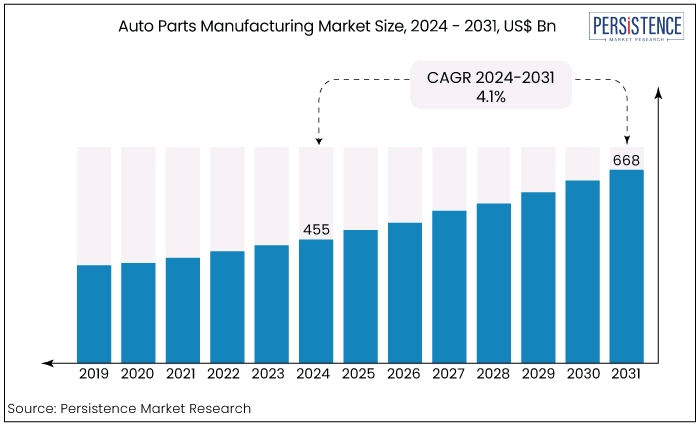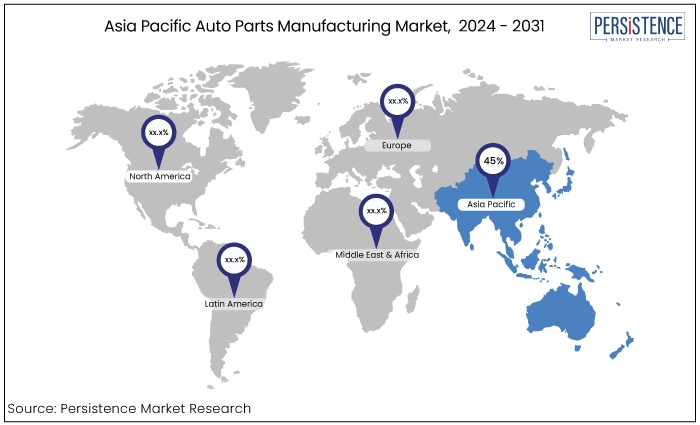Industry: Automotive & Transportation
Published Date: September-2024
Format: PPT*, PDF, EXCEL
Delivery Timelines: Contact Sales
Number of Pages: 173
Report ID: PMRREP3544
The auto parts manufacturing market is estimated to increase from US$455 Bn in 2024 to US$668 Bn by 2031. The market is projected to record a CAGR of 4.1% during the forecast period from 2024 to 2031. The market growth is attributed to the growth in vehicle production and sales and innovations in automotive technology, such as electric vehicles and advanced driver-assistance systems.

Key Highlights of the Market
|
Market Attributes |
Key Insights |
|
Market Size (2024E) |
US$455 Bn |
|
Projected Market Value (2034F) |
US$668 Bn |
|
Global Market Growth Rate (CAGR 2024 to 2034) |
4.1% |
|
Historical Market Growth Rate (CAGR 2019 to 2023) |
3.8% |
|
Region |
Market Value Share 2024 |
|
Asia Pacific |
45% |
Asia Pacific market region is experiencing significant growth as a result of increasing industrialization, urbanization, and the expansion of the automotive industry. Asia Pacific is the leading automotive market in the world.
Asia Pacific serves as a center for manufacturing taking advantage of reduced production expenses, a highly trained labor population, and a robust supply chain network. Also, the growth of the car parts manufacturing market in the region is driven by the increasing middle class, rising disposable incomes, and developing transportation infrastructure.

Ongoing technical breakthroughs and a strong manufacturing infrastructure drive the market growth in North America. Prominent automobile manufacturers inhabit North America and experience a significant need for automotive components as a result of a substantial number of vehicles in operation.
North America leads the way in the development of electric vehicles, autonomous driving technology, and sophisticated safety features. This presents chances for manufacturers to provide components for these new sectors.
|
Category |
Market Share in 2024 |
|
Vehicle Type - Passenger Vehicles |
55% |
Based on vehicle type, the global auto parts manufacturing market is further divided into passenger vehicles, and commercial vehicles. Among these, the passenger vehicles segment dominates the market. This segment is expected to achieve substantial market value and is forecasted to expand at a notable CAGR rate.
Investments in transportation infrastructure such as the construction of roads, highways, and charging stations for electric vehicles can enhance accessibility and convenience for individuals who own passenger vehicles. Improved infrastructure promotes high rates of personal car ownership and usage.
Government incentives such as tax credits for the purchase of electric vehicles, subsidies for programs that recycle old vehicles, and incentives for vehicles that are fuel-efficient are expected to boost the demand for passenger vehicles.
|
Category |
Market Share in 2024 |
|
Component - Engine |
41% |
The auto parts manufacturing market is classified into engine, batteries, and cooling systems,
based on component. Among these, the engine component segment dominates the market accounting for 40% market share in 2024.
Engine components include crucial parts such as pistons, valves, crankshafts, and camshafts, all essential for the internal combustion engine (ICE). Despite the growing shift toward electric vehicles (EVs), ICE vehicles continue to dominate the market particularly in developing regions sustaining high demand for engine components.
Manufacturers are focused on enhancing fuel efficiency and reducing emissions, which are critical concerns for regulatory compliance and environmental sustainability. Material science advancements such as using lightweight alloys are helping reduce engine weight and improve overall vehicle performance.
The ongoing need for vehicle maintenance and the replacement of engine components further solidifies segment's dominance in the auto parts manufacturing market.
The market for auto parts manufacturing has gone under a notable transition toward the development of electric vehicles (EVs) as several prominent manufacturers are increasing the production of their current EV models.
The emphasis on electric vehicle (EV) manufacturing is mostly driven by EPA regulations, mandating that two-thirds of newly manufactured vehicles must be electric by 2030. The increasing use of electric vehicles (EVs) demonstrates manufacturers' recognition of the need to comply with environmental regulations and support sustainable transportation alternatives.
With the expanding emphasis on electric vehicle (EV) manufacturing, there is a rising demand for components that are specifically designed for EVs. These components encompass batteries, electric motors, power electronics, and other specialized parts that are exclusive to electric vehicles (EVs). As a result, automobile parts manufacturers have been obligated to modify their production processes and allocate resources to research and development to satisfy the increasing demand.
Implementing automation in production and deploying IoT are fundamentally transforming the auto parts manufacturing industry. Technological advancements facilitate manufacturers in accelerating and enhancing the manufacturing process, mitigating risks, and monitoring equipment. Consequently, stimulating the market growth.
The auto parts manufacturing market experienced steady growth leading up to 2023 driven by the robust demand for vehicles particularly in emerging economies, and the ongoing need for vehicle maintenance and repair.
During the period from 2019 to 2023, the market benefited from the strong sales of internal combustion engine (ICE) vehicles, which required a wide range of components such as engine parts, transmission systems, and exhaust systems.
The market also experienced significant advancements in materials and manufacturing technologies leading to light and durable parts, which contributed to overall market expansion. Post-2024, the market is expected to transform significantly primarily influenced by the global shift toward electric vehicles (EVs) and the increasing adoption of advanced driver-assistance systems (ADAS).
The demand for traditional ICE components is anticipated to decline, while the focus will shift toward manufacturing parts for EVs such as batteries, electric drivetrains, and power electronics.
The rise of autonomous and connected vehicles will likely spur growth in the electrical and electronics components segment. However, this transition may also pose challenges for traditional auto parts manufacturers requiring them to innovate and adapt to new technologies and market demands to sustain growth in the evolving automotive landscape.
Rising Vehicle Production and Sales in Emerging Markets
The increasing vehicle production and sales in emerging markets such as China, India, and Southeast Asia are the key growth drivers for the auto parts manufacturing market. These regions have seen significant economic growth leading to rising middle class with more significant disposable income fuelling automobile demand.
Governments in these countries are also investing significantly in infrastructure making vehicle ownership more accessible and desirable. As a result, the demand for new vehicles and replacement auto parts has surged creating opportunities for manufacturers to expand their operations and capture market share. Establishing manufacturing plants by global automakers in these regions has led to a growing demand for locally produced auto parts, further boosting the market.
Technological Advancements and Innovation
Technological advancements and innovation are key drivers for the market growth. The industry is witnessing rapid developments in materials science, manufacturing processes, and product design leading to the production of light, durable, and more efficient auto parts.
Innovations such as 3D printing, robotics, and advanced automation are revolutionizing the manufacturing process reducing production costs, and improving precision. The increasing trend toward electrification and the development of electric vehicles (EVs) are driving demand for specialized components such as high-performance batteries, electric drivetrains, and power electronics.
The technological advancements not only enhance vehicle performance and safety but also enable manufacturers to meet stringent environmental regulations positioning them for growth in competitive market.
Shift Toward Electric Vehicles (EVs)
The global shift toward electric vehicles (EVs) significantly restraints the traditional auto parts manufacturing market particularly for manufacturers mainly reliant on components for internal combustion engines (ICEs).
EVs require fewer moving parts and mechanical components than ICE vehicles, which reduces the demand for parts such as exhaust systems, fuel injectors, and engine components. This transition poses a challenge for manufacturers who need to adapt their product lines and invest in new technologies to remain competitive.
The rapid pace of EV adoption driven by stringent environmental regulations and government incentives accelerates this shift potentially leading to a decline in demand for traditional auto parts.
Volatility in Raw Material Prices
Volatility in raw material prices is another significant restraint for the market. The production of auto parts relies mainly on raw materials such as steel, aluminum, and plastics, whose prices can fluctuate due to factors like global supply chain disruptions, trade policies, and economic instability.
The price fluctuations can lead to increased production costs, squeezing profit margins for manufacturers. The ongoing geopolitical tensions and trade wars have exacerbated supply chain uncertainties making it difficult for manufacturers to maintain consistent pricing and supply.
The volatility not only impacts the financial stability of auto parts manufacturers but also affects their ability to forecast and plan for future production potentially hindering market growth.
Expansion into Electric Vehicle (EV) Component Manufacturing
The growing demand for electric vehicles (EVs) presents a significant opportunity for the auto parts manufacturing market especially as the automotive industry undergoes a major shift toward electrification.
As countries around the world implement strict emissions regulations and offer incentives for EV adoption, the market for EV components is poised for substantial growth. This shift opens up new avenues for auto parts manufacturers to diversify their product portfolios and tap into the rapidly expanding EV market.
Manufacturers can capitalize on this opportunity by focusing on producing specialized components essential for EVs such as battery systems, electric drivetrains, power electronics, and charging infrastructure.
The demand for high-performance batteries in particular is expected to surge as automakers strive to improve the range and efficiency of their EVs. Components like lightweight materials, advanced thermal management systems, and regenerative braking systems are becoming increasingly important in EV design offering further opportunities for innovation and market entry.
Auto parts manufacturers that can establish themselves as key suppliers in the EV aftermarket stand to benefit from a steady revenue stream as the global fleet of electric vehicles expands. To fully leverage this opportunity, auto parts manufacturers must invest in research and development, establish strategic partnerships with EV manufacturers, and adapt their production capabilities to meet the unique requirements of electric vehicles.
The leading competitors in the market are primarily evaluated based on their product or service offerings, and the company's position in the global market scenario and its geographical reach. Also, key competitors in the industry employ crucial strategies like partnership deals, mergers and acquisitions, and business expansion deals to strengthen their hold on a particular region.
Recent Industry Developments in the Auto Parts Manufacturing Market
|
Attributes |
Details |
|
Forecast Period |
2024 to 2031 |
|
Historical Data Available for |
2019 to 2023 |
|
Market Analysis |
US$ Billion for Value |
|
Key Region Covered |
|
|
Key Market Segments Covered |
|
|
Key Companies Profiled |
|
|
Report Coverage |
|
|
Customization & Pricing |
Available upon request |
By Component
By Vehicle Type
By Sales Channel
By Region
To know more about delivery timeline for this report Contact Sales

The market is estimated to be valued at US$455 Bn in 2024
The market is projected to exhibit a CAGR of 4.1% over the forecast period.
A few of the key industry players in the market are Robert Bosch GmbH, Denso Corporation, and Valeo SA.
Asia Pacific is the dominant regional market for auto parts manufacturing.